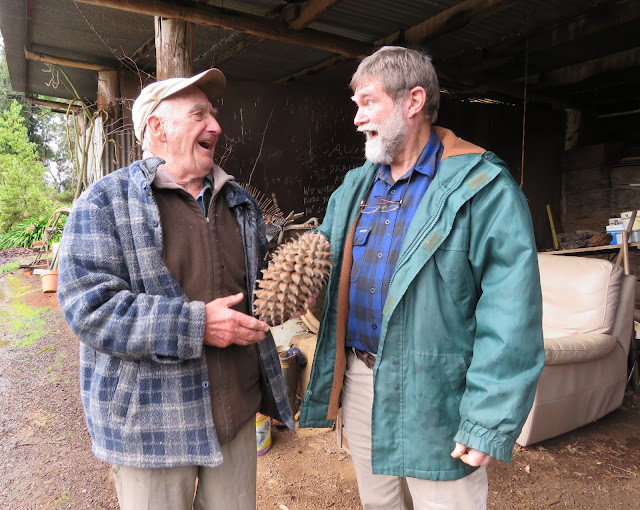One who seeks its shade should wear a hard hat
 |
| Geoff Bogle and Don Teese, with the giant cone from Coulter's Pine |
In 1831, the medical doctor and plant enthusiast, Thomas Coulter, was collecting plants in the Santa Lucia mountains, in southern California, when he chanced upon a pine with cones the size of an American (or for that matter an Australian Rules) football. Sadly for this story, but thankfully for Dr Coulter, no cones fell on him.
The trees were 12-20 metres high, with needles in bundles of three - to identify a pine you should always count the number of needles (thin leaves) held within each papery sheath.
The cones are the heaviest and among the largest of the pines, weighing in at around two to three kilograms and often 30 centimetres in length (there are pines with longer cones). They are also rather prickly to touch, with aggressive spines at the tip of each cone scale.
In recognition of Dr Coulter's efforts, the tree was named Pinus coulteri, and is commonly called either Coulter's Pine or, simply, Big Cone Pine. It grows naturally from San Francisco south to the top end of the Gulf of California, in Mexico.
Coulter collected over 50,000 plant specimens in his travels through California and Mexico, sending his collections back to his home town of Dublin, which is where I expect the 'Type' (reference) specimen of this species resides.
As with many pines, the seeds are edible and were gathered by local Native Americans to be eaten raw or cooked. The resin from the wood, as with all pines, contains turpentine, which most Australians know as a small glass or plastic bottle forgotten at the back of their laundry cupboard until the need to clean some paint brushes.
The bark is deeply fissured, and on the rather damp day I saw this specimen, hinting at that orangy-red colour of the new resinous shoots. Apart of the rather large, spiny cones, the thick new shoots and young branches, a few of which are wiggling around in front of the trunk in this picture, are distinctive.
The perhaps self evident title of this post is taken from the Flora of North America account of this species, and I assume is was originally a piece of Native American wisdom. Next week, another pine from the Americas, this time from further south, in Mexico and Central America.
The perhaps self evident title of this post is taken from the Flora of North America account of this species, and I assume is was originally a piece of Native American wisdom. Next week, another pine from the Americas, this time from further south, in Mexico and Central America.
All but the next picture in this post are from Geoff Bogle's arboretum, although we do have two specimens of Coulter's Pine in Melbourne Gardens. One of these, illustrated below, was planted only three years ago, by His Imperial Highness Prince Ermias Sahle-Selassie Haile-Selassie (President of The Crown Council of Ethiopia). Prince Ermias planted this tree as an historical nod to his father's planting of an Atlas Cedar in Melbourne Gardens, in 1964.
Coulter's Pine is one of Geoff's favourite trees, and it is (metaphorically) growing on me too. Here is Geoff's again, in his arboretum, with a few more year's growth on it than the Prince's.
Coulter's Pine is one of Geoff's favourite trees, and it is (metaphorically) growing on me too. Here is Geoff's again, in his arboretum, with a few more year's growth on it than the Prince's.





Comments
Keep up the great posts, Tim. Most enjoyable!